This paper investigates whether and to what extent the proximity of the court location and the nearest university affect court’s productivity. We exploit data from Italian Ministry of Justice during the period 2014 – 2021 by considering the length of proceedings as outcome variable. Results show that the average time to conclude legal proceedings increases as the distance courts-universities increases. However, only courts located in the Centre-North of Italy benefit from the spatial spillovers deriving from the proximity to the university.
1. Introduction
Civil justice’s efficient and efficacy operation is vital to the economy. Indeed, being an essential element guaranteeing the protection of property rights and the enforcement of contracts, it spurs the accumulation of capital, the financing of firms, the efficient allocation of resources and, ultimately, the competitiveness and growth potential of a territory (Knack and Keefer, 1995; La Porta et al., 1997; Marchesi, 2003; Jappelli et al., 2005; Giacomelli and Menon, 2016; Accetturo et al., 2017; Giacomelli et al., 2017; Decarolis et al., 2021).
The justice performance embraces several dimensions largely investigated in the literature. According to Staats et al. (2005), there are five elements that determine the judicial performance such as independence, efficiency, accessibility, accountability and effectiveness. Moreover, both judicial performance and judicial efficiency is affected by the court quality, in turn, influenced by the substantive law, the judicial decision-making, and the judicial administration (Dakolias, 1999). Yet, court delay might also be driven by unclear or inconsistent legislation (Di Vita, 2010; 2012). Focussing on the latter point, the research aiming to identify its drivers suggests several determinants in play. According to Voigt (2016), some factors that are likely to determine the supply of court output could be the number of judges per capita (controlling for education, age, experience), career possibilities, the number and quality of staff, the complexity of the judicial system itself, the public spending on justice. Furthermore, other key elements are related to the management of cases filed such as the complexity of cases filed, the amount of time judges dedicate to tasks, and the available technology (Pastor, 1993; Buscaglia and Ulen, 1997; Fix Fierro, 2003; Buscaglia, 2006). Indeed, the performance of the justice system involves a combination of factors such as work (judges, clerks, officers, and agents), capital (buildings and offices) and technology (computers and computer software) (Rosales-López, 2008). In this respect, Kittelsen and Fordsun (1992) and Pedraja and Salinas (1995), considering that the courts are “labour-intensive” units of production, have examined judicial efficiency using the technique of Data Enveloped Analysis by including as input the labour factor.
Higher educated human capital boost efficiency and productivity in any production function (see, among others, Barron et al., 1987; Bartel, 1989; Bishop, 1994; Black and Lynch, 1996; McGuirk et al., 2015; Onkelinx et al., 2016). In this respect, the university system is on the front line in human capital accumulation as its role in building and diffusion of knowledge (Mokyr, 2002). Universities are producers of human capital, and skilled workers are more productive than unskilled workers (Valero and Van Reenen, 2019). In addition, by increasing the educational supply, universities positively affect innovation (Bloom et al., 2017; Valero and Van Reenen, 2019; Feng and Valero, 2020). Yet, several empirical papers have found that universities increase innovative local capacity (Fischer and Varga, 2003; Belenzon and Schankerman, 2013). According to Card (2001), geographical distance seems to matter because areas with more developed universities increase benefits from the higher chances that locally-born people will join the university and also because students who graduate tend to establish themselves in the area where the university is located (Valero and Van Reenen, 2019). As explained by Bonaccorsi et al. (2004), knowledge has a restricted spatial range. Despite its capability to cross the boundaries of the source that makes it, its impact decreases with distance (Bonaccorsi et al., 2004).
Moving from these considerations, we analyse the university’s contribution in territorial contexts (see Grassi et al., 2022) by investigating whether and to what extent the proximity of the court location and the nearest university is correlated with the court’s productivity. In more detail, we consider the length of the proceedings following, among others, Cugno et al. (2022). In doing so, our goal is to provide further insight into the involvement of university research in the Arrow-Marshall-Romer externalities in the context of court productivity, which is a public good. Contrariwise, previous literature mainly shows, to the best of our knowledge, that the research produced by universities, a public interest, leads to a higher output on the part of the private sector (Anselin et al., 2000). Thus, we contribute to the literature investigating how far – from a spatial point of view – different forms of privately and publicly produced knowledge spread their effects, being relatively scant evidence on this debate.
To shed light on this strand of literature, we exploit data provided by the Italian Ministry of Justice from 2014 to 2021 on trial duration in each court in Italy. Regarding the proximity between the court and the nearest university comprising the department of law, we hand-collected information on the distance between these two places from Google Maps in terms of driving distance. Moreover, we allow for territorial heterogeneity as we examine whether the relationship under scrutiny exerts a diverse impact, discriminating between courts located in the Central-Northern and Southern regions of the country.
The estimation results show that the average time to finalise legal proceedings is negative correlated with the distance between courts and universities increases. Hence, a public institution’s productivity is lower when it cannot benefit from the proximity of human capital provided by universities. This result is confirmed by further checks using the number of universities within the district as a main regressor. When we deeply inspect the phenomenon by disaggregating the country’s macro-areas, it emerges that courts operating in the Centre-North benefit from spatial spillovers deriving from the proximity to the university. An explanation of this finding, in line with the arguments of Card (2001) and Valero and Van Reenen (2019), can rely on potential opportunities that tend to be higher for locally-born people will join the university in these regions and for graduated students being more likely to find a job in the same area where they undertake university studies. By contrast, the lack of stable and satisfactory job opportunities for people with a higher level of education, which also translates into a phenomenon of depopulation of these regions and transfer of human capital, could justify the evidence emerging in the southern areas.
In our investigation, omitted variables represent a serious threat for a causal interpretation of our findings. Even though we control for a set of socio-economic characteristics at the District Court level (such as firm and population density, education level, seniority index, and the extent of banking services) our specification suffers the lack of information at the court level relevant for explaining the supply of court output (see, for instance Voigt, 2016). Notwithstanding the limitation of this work, to the best of our knowledge, we are the first to document a relationship between the University-Court proximity and the court’s productivity. While we do not have elements to claim a causal interpretation of our analysis, we provide a supportive evidence and provide a starting point for future researches.
The remainder of this work is organised as follows: the next section describes the data and the estimated model employed. In section 3 we discuss the results, while section 4 concludes.
2. Data and estimated model
2.1 Data
Data used for the econometric analysis come from the Italian Ministry of Justice (Ministero della Giustizia) website.[1] In particular, the Ministry’s General Management of Statistics and Organisational Analysis (DG-Stat)[2] provides disaggregated data on the average duration of court proceedings at the district level of Italian courts.[3]
More in detail, we consider 139 Italian districts for the period 2014-2021, namely all available years. The sample only includes civil proceedings disaggregated by the legal field, and the lack of disaggregated data at the legal field level justifies the exclusion of penal proceedings.
As a measure of the distance between the court and the nearest university with a law department, we have hand-calculated the driving distance between the two considered places using google maps. Thus, our indicator is expressed in kilometres, considering several universities may locate departments in other cities.[4] We also collected the number of universities with a district law department as an additional check.
Finally, data on municipalities’ characteristics (i.e. personnel indicators, demographic characteristics, and economic development), aggregated in districts of Italian courts, are obtained from ISTAT (Italian National Institute of Statistics).[5]
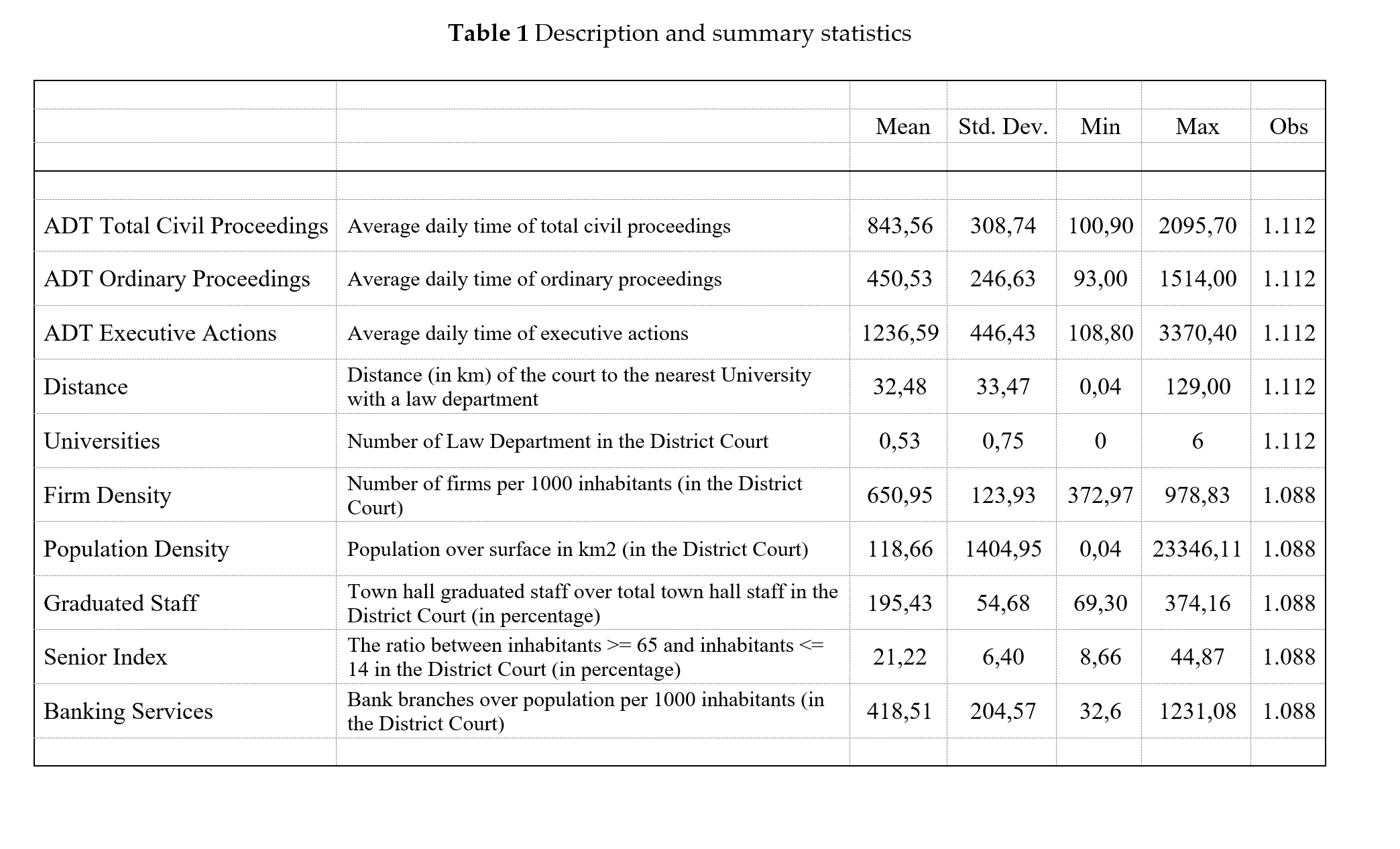
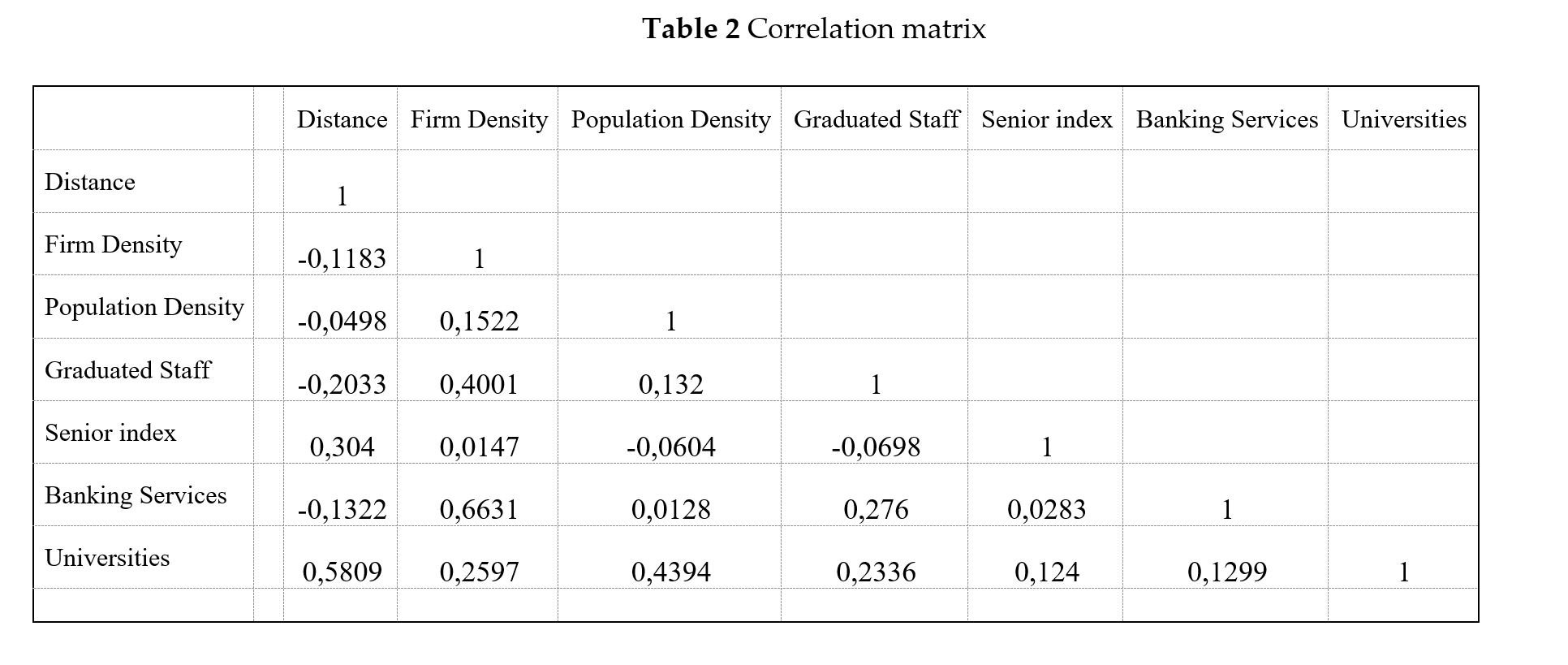
2.2 The estimated model
The estimated equation is specified as follows:

where y represents the measure of the productivity of court i at time t. We consider the length of the proceedings as a performance profile of a court following, among others, Cugno et al. (2022).[6] In detail, the dependent variable is, alternatively, the average daily time of total civil proceedings (ADT Total Civil Proceedings). Furthermore, we divided civil proceedings into ADT Ordinary Proceedings and ADT Executive Actions to control for two different fields of civil law.[7]
On the right side of equation (1), the key variable of the analysis is Distance, computed as the distance (expressed in kilometres) of the court to the nearest university with a law department.[8] Moreover, considering territorial characteristics (at the District Court level),[9] we control for Firm Density and Population Density, representing the number of firms per 1000 inhabitants and the population over the surface (in square kilometres), respectively. Also, we include in the model the ratio between the town hall graduated staff and the entire town hall staff (Graduated Staff) and that of the older people (age >= 65) over the young population (age<= 14) (Senior Index). Finally, we account for the presence of banks by considering a measure of density computed as bank branches over population per 1000 inhabitants (Banking Services). A more detailed description of the variables employed in the estimations, alongside some of their main summary statistics, are reported in Table 1 – while Table 2 provides a correlation matrix.
As explained in the previous section, the data available do not allow us to control for a series of characteristics at the court level that has been proved to be relevant in determine the supply of court output (see, among others, Voigt, 2016). Thus, omitted variables issue is a main concern in our analysis that prevent us to claim any causal-nexus.
3. Estimation results
3.1 Main results
Table 3 shows the estimation results of equation (1). In column 1, we report estimates of the average daily time of total proceedings (ADT Total Civil Proceedings). Columns 2 and 3 regard the estimations of only a segment of Ordinary Proceedings and Executive Actions.
Focusing on the key variable of the analysis (Distance), it has a positive and statistically significant coefficient at a 1 per cent level (column 1), meaning that the distance between the nearest university and the courthouse positively influences the needed time to conclude proceedings, i.e., the higher the length, the lower the productivity. Similar evidence is found when considering ADT Ordinary Proceedings and ADT Executive Actions as dependent variables. According to columns 2 and 3, the distance between the court and the university positively affects the average time for ordinary proceedings (column 2) and executive actions (column 3). Regarding control variables, a greater presence of firms and banking services in the area reduces the average process time, as does a higher percentage of public service graduates.
Figure 1 further confirms the positive relationship between the university-court distance and the average duration of proceedings. As we can see from Figures 2 and 3, this positive relationship also emerges when splitting the proceedings according to the above description.
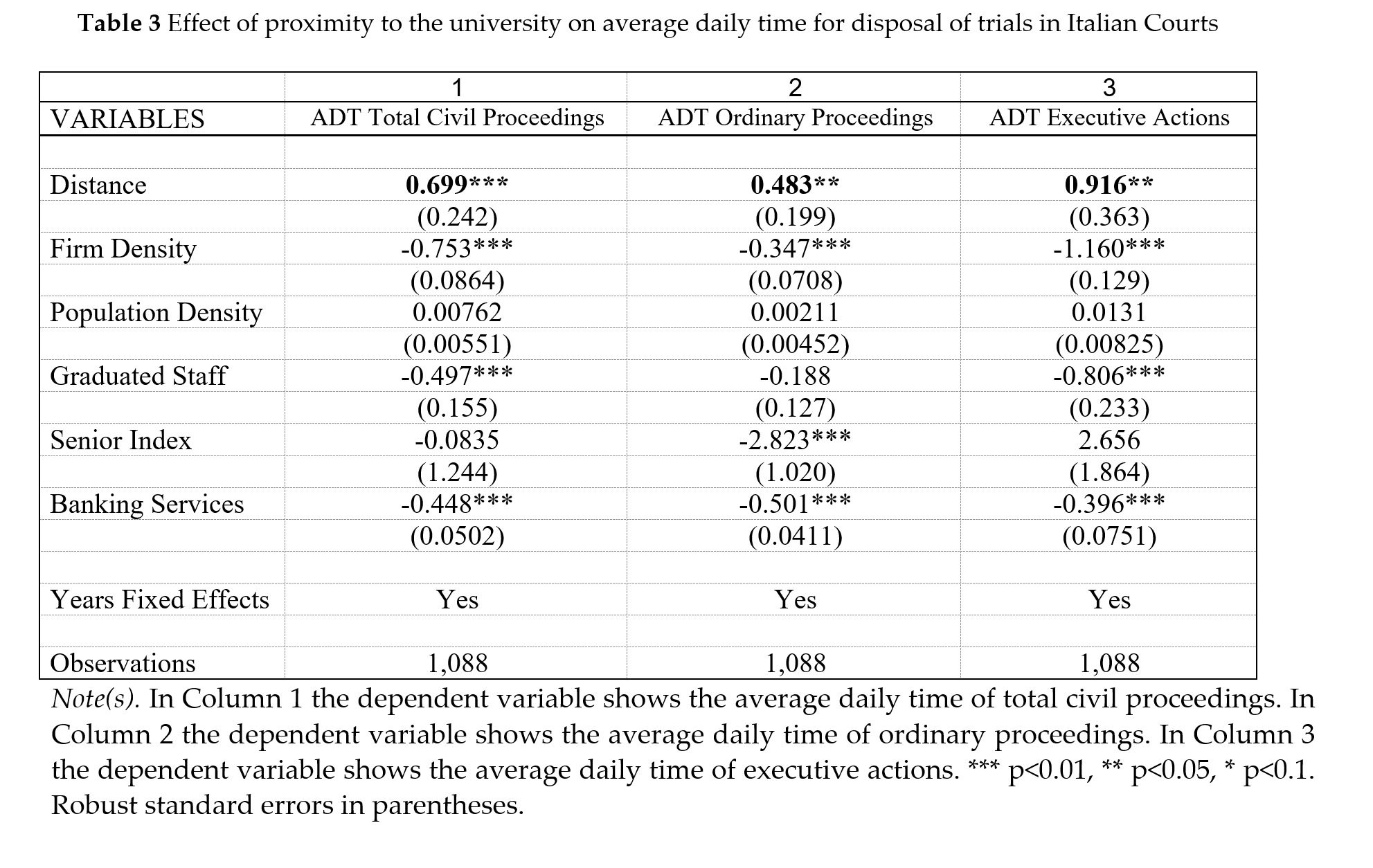
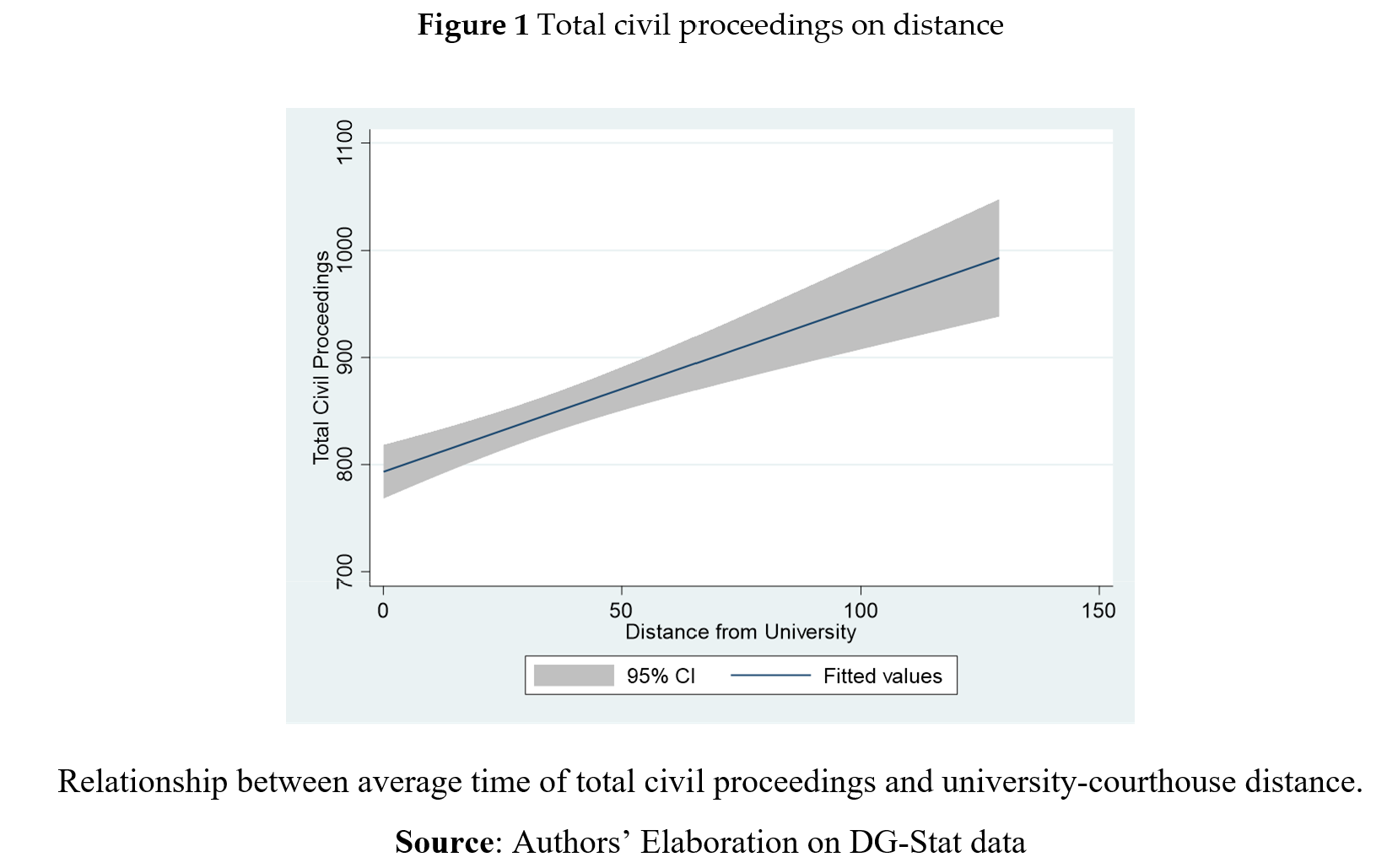
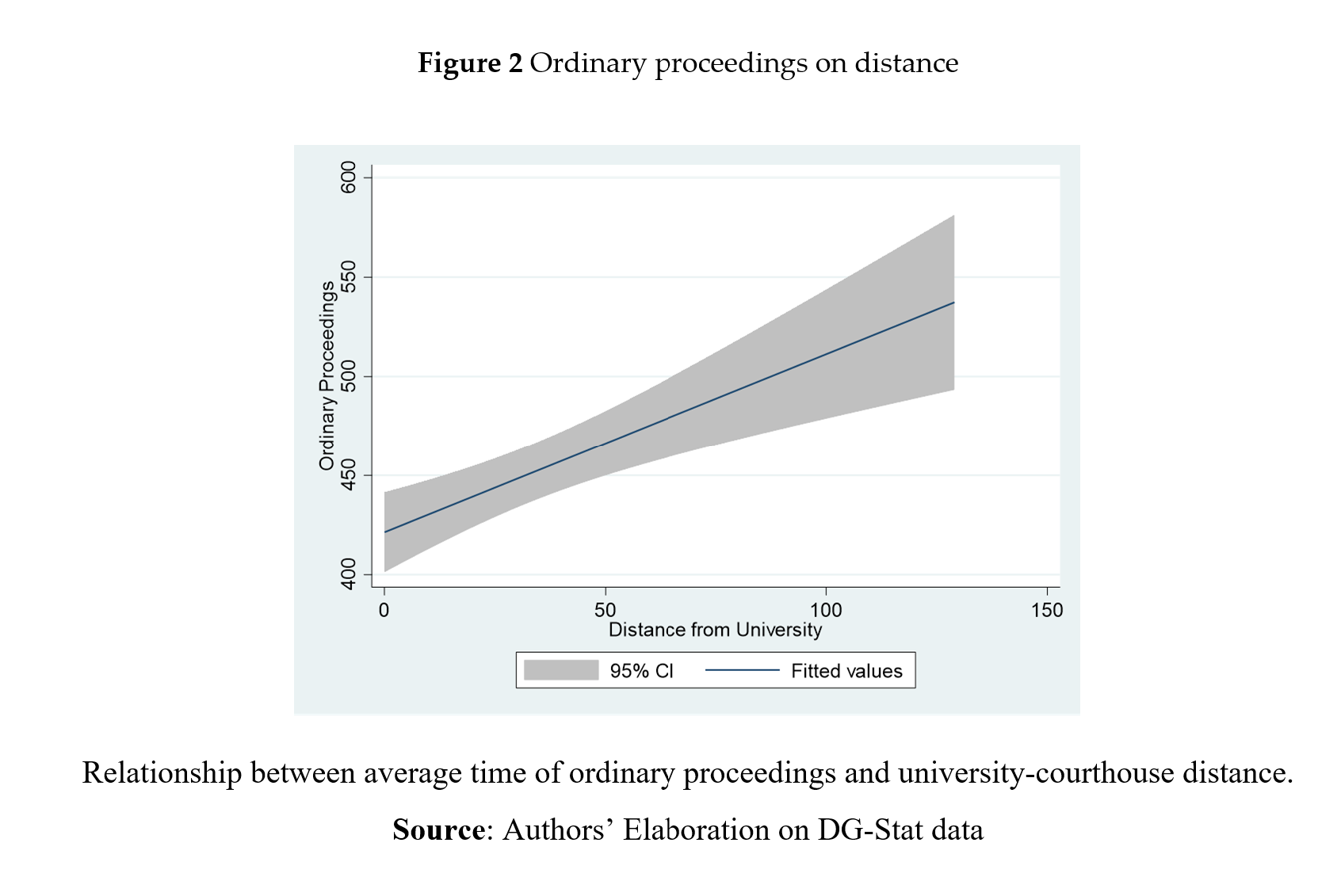
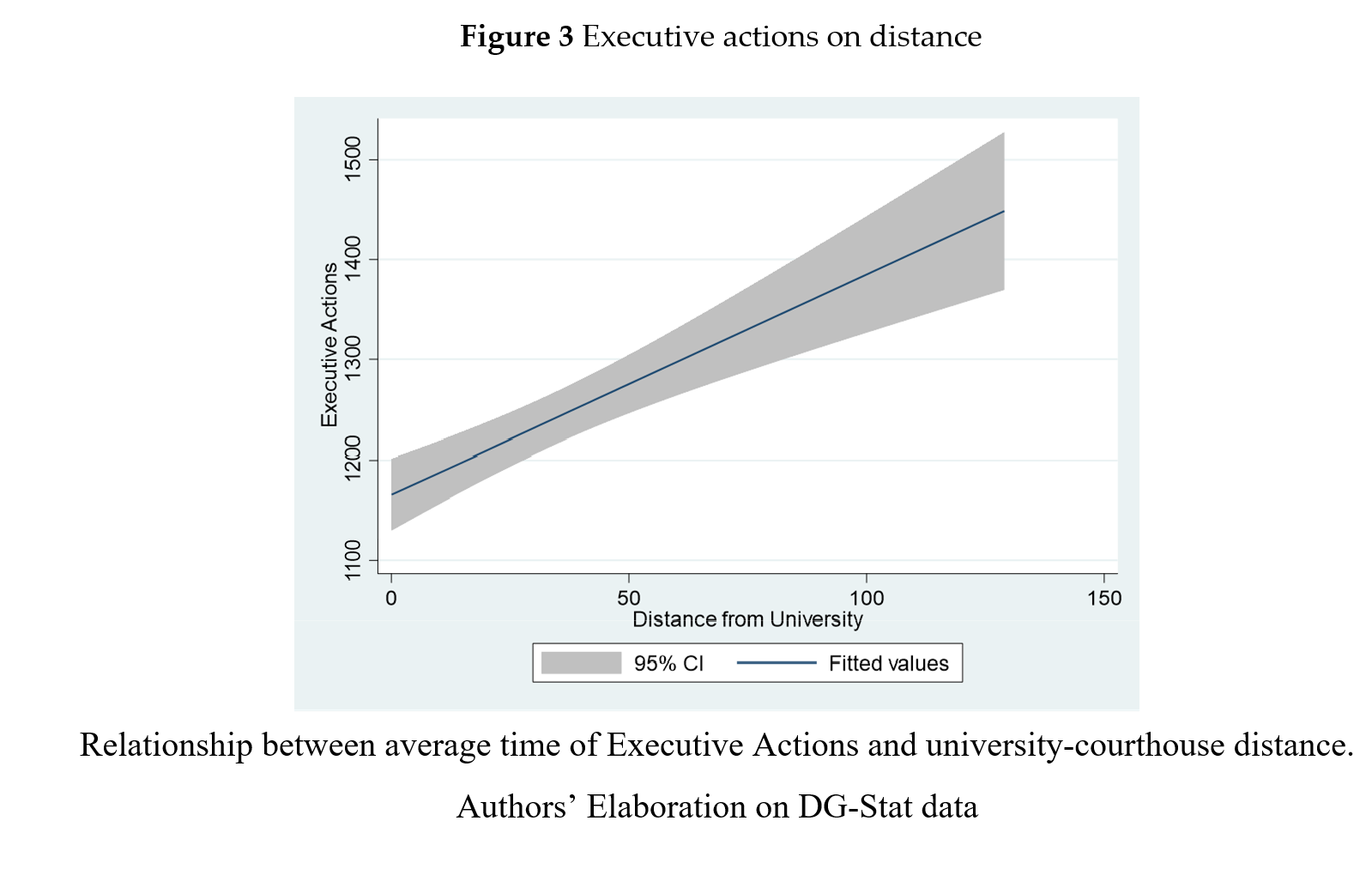
In Table 4, we divide the sample between Central-North and South Italy to investigate whether there is a heterogenous impact across these two macro areas.[10] In column 1, we report ADT Total Proceedings estimates in the Centre-North, confirming the results described in Table. This result provides other proof of the North-South divide debate.[11] In particular, it emphasises that the presence and proximity of universities, and thus a massive presence of human capital, does affect the courts’ production processes in more developed areas of the country.
Similar evidence is found when employing ADT Ordinary Proceedings and ADT Executive Actions as dependent variables. Results show that in the Centre-North, the presence and proximity of universities, especially law departments, positively affect the productivity of courts for both ordinary proceedings (column 3) and executive actions (column 5). While columns 4 and 6 indicate no effect in southern Italy for both fields.
As a first robustness check, Table A1 and A2 show the results of estimating equation (1) for each legal area. Table A1 shows the average daily time estimates of the different areas of executive actions. The variable Distance has a positive and statistically significant coefficient at a 5% level for Bankruptcy Proceedings and Claims for Bankruptcy, (columns 1 and 2). Furthermore, it has a positive and statistically significant coefficient at a 1% level for Real Estate Executions (column 3) and finally a positive and significant coefficient for Moveable Executions (column 4).
This means that the distance between the nearest university and the court positively influences the time it takes to conclude proceedings in all legal areas of executive actions. Regarding control variables, results of Table 3 are confirmed.
Similar results in Table A2 where we disaggregate the legal areas of ordinary civil law. The results show that Distance from universities significantly influences ordinary civil proceedings per sè, labour proceedings and special procedures. We find no effect on Insolvency Proceedings and Welfare.
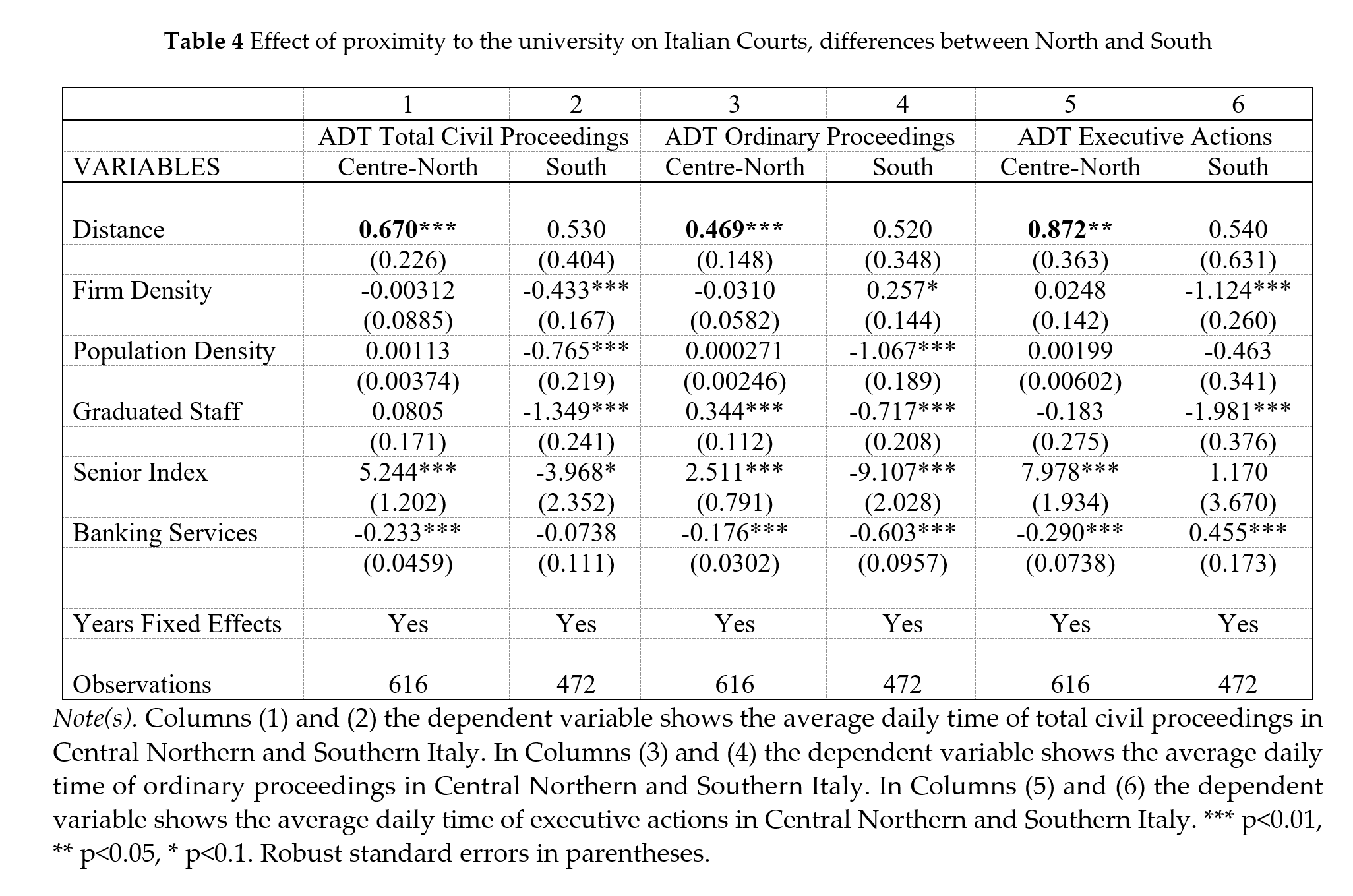
3.2 Additional insights
As a further robustness check, we replicate the analysis using an alternative to Distance, that is the number of universities in the judicial district (hereafter Universities).
Table 5, consistent with our main results, shows that the Universities coefficients are negative and statistically significant (columns 1-3), an increase in law departments in the districts leads to a reduction in court time.
As done in the previous section, in Table 6, we divide the sample between Central-Northern and Southern Italy. The main results are confirmed and show that in the Centre-North, a higher presence of law faculties reduces the time for court proceedings, both for ordinary proceedings (column 3) and executive actions (column 5). While columns 4 and 6 show no effect in Southern Italy for both sectors confirming the disparity between the geographical areas.
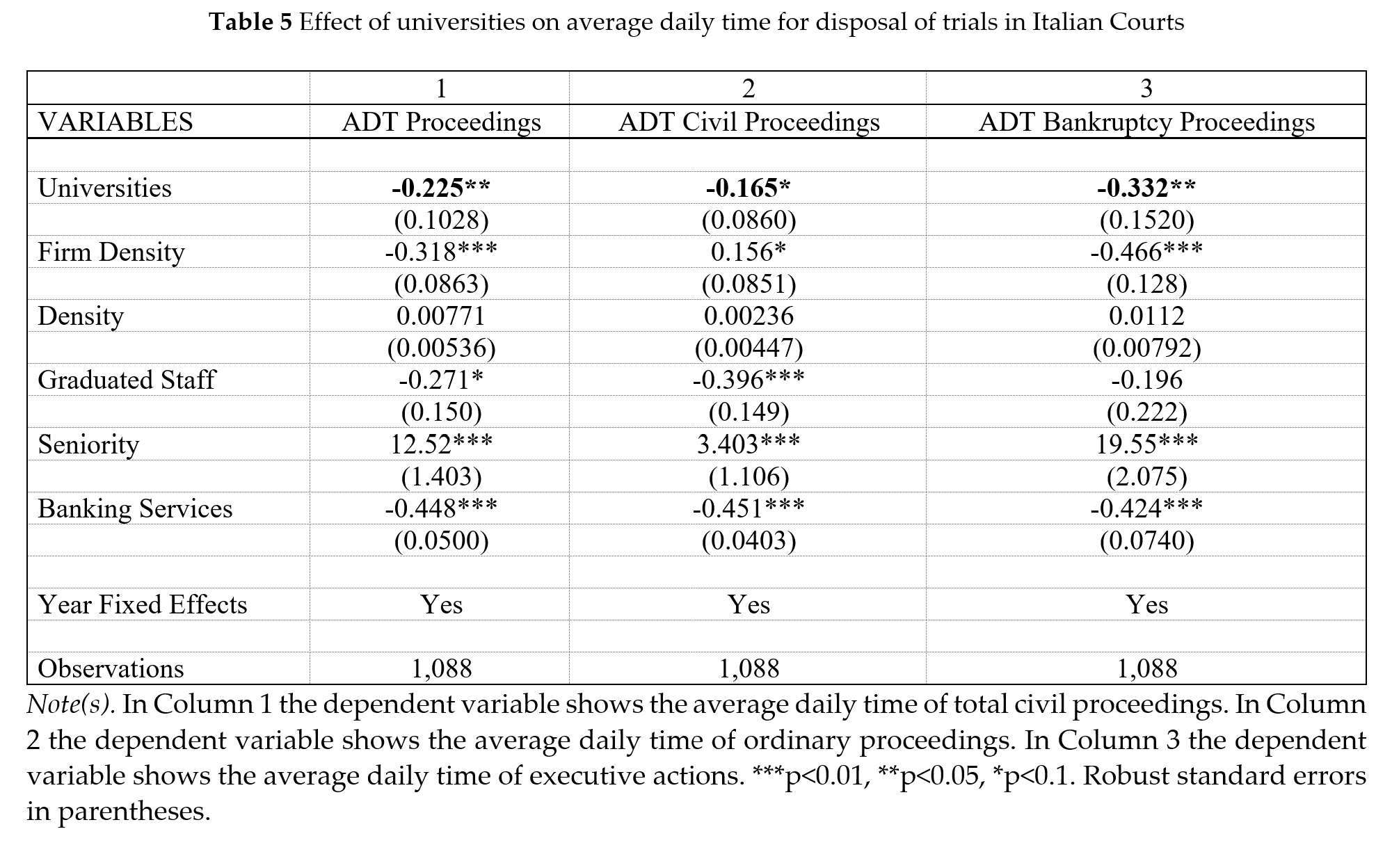
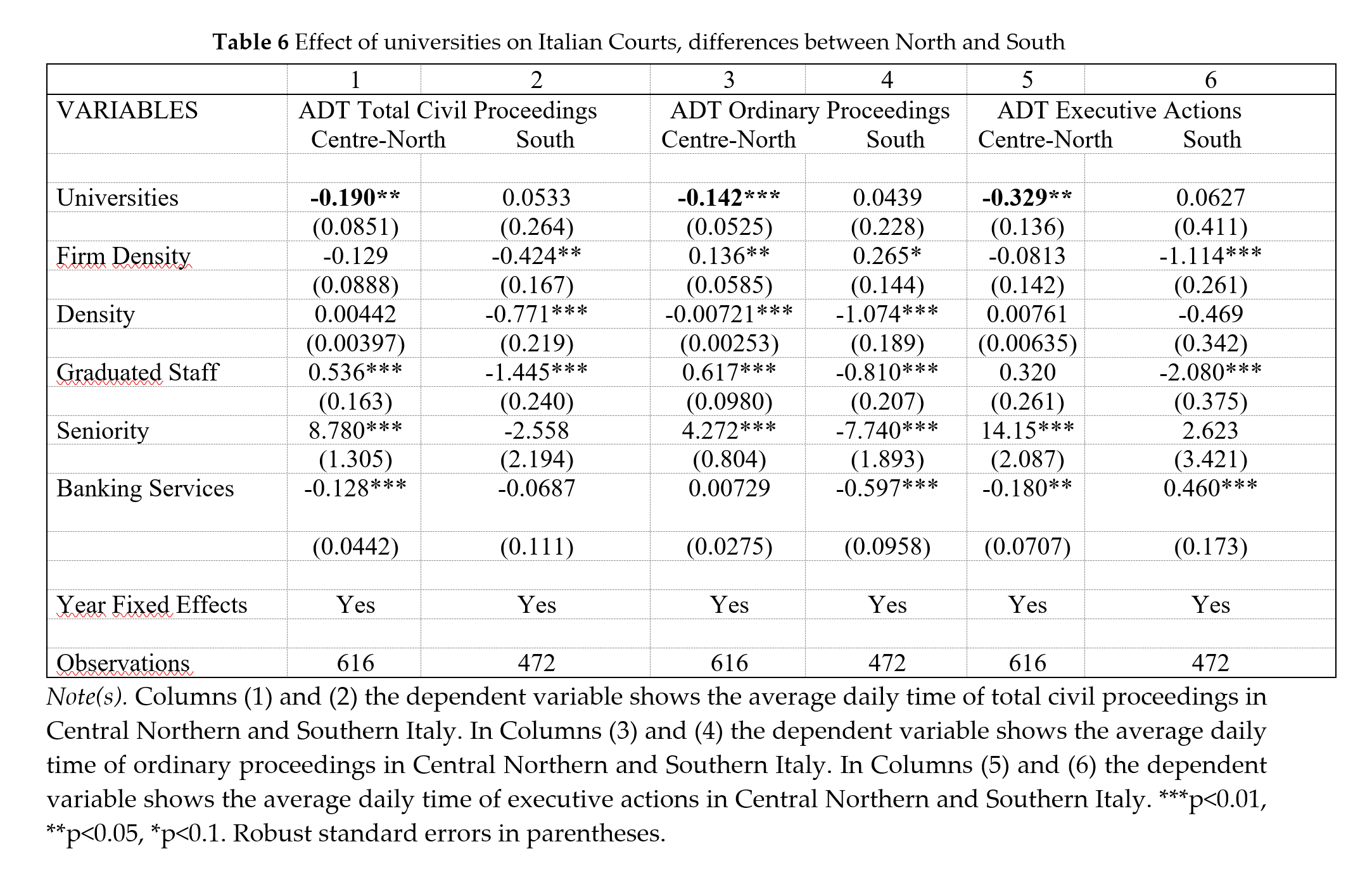
4. Concluding remarks
In this study, we document the critical role played by the human capital provided by universities in influencing courts’ productivity. Employing data supplied by the Italian Ministry of Justice during the period 2014 – 2021, we provide evidence of the positive relationship between university-court distance and the average time of civil trials. Stated differently, courts’ productivity benefits from the nearness to research and innovation centres and the presence of associated human capital. The results are confirmed by further analyses showing that a greater presence of university locations reduces the average civil court time.
What is more, our results contribute to the well-established North-South divide debate. Indeed, we allow for territorial heterogeneity as we investigate whether the distance between universities and courts exerts diverse effects on the latter’s productivity, discriminating between courts located in the Central-Northern and Southern regions of the country. Our evidence suggests that university-court distance fosters courts’ productivity only in the Centre and North of Italy. The latter, indeed, represents that part of the country which is also more likely to benefit from human capital that is locally created and maintained, justifying the positive influence of public knowledge spillovers to public legal services and systems.
As a matter of fact, the literature has shown the importance of knowledge spillovers for the private sector output. By contrast, we offer evidence of the significance of knowledge spillovers, which also emerges in the context of good public performance. As a result, increasing the connections between courts and universities would lead to more efficient and effective courts with constructive effects on the whole community. In the Mezzogiorno, this kind of intervention target could be even more valuable in improving the legal system, one of the main factors affecting economic growth (see, among others, Levine et al., 1998).
Future research is called to extend our investigation by using alternative methods to measure the performance and it could be examined whether the proximity of universities to the courthouses has an impact on the disposal of pending proceedings using data on incoming and outgoing proceedings.
References
- Accetturo, A., Linarello, A. and Petrella, A., 2017. Legal enforcement and global value chains: micro-evidence from Italian manufacturing firms. Bank of Italy Occasional Paper, (397).
- Anselin, L., Varga, A. and Acs, Z.J., 2000. Geographic and sectoral characteristics of academic knowledge externalities. Papers in Regional science, 79, pp.435-443.
- Antonucci, L., Crocetta, C. and d’Ovidio, F.D., 2014. Evaluation of Italian judicial system. Procedia Economics and Finance, 17, pp.121-130.
- Barron, J.M., Black, D.A. and Loewenstein, M.A., 1987. Employer size: The implications for search, training, capital investment, starting wages, and wage growth. Journal of Labor Economics, 5(1), pp.76-89.
- Bartel, A.P., 1989. Formal Employee Training Programs and Their Impact on Labor Productivity: Evidence from a Human Resources Survey. NBER Working Paper, (w3026).
- Belenzon, S. and Schankerman, M., 2013. Spreading the word: Geography, policy, and knowledge spillovers. Review of Economics and Statistics, 95(3), pp.884-903.
- Bishop, J., 1994. The impact of previous training on productivity and wages. In Training and the private sector: International comparisons (pp. 161-200). University of Chicago Press.
- Black, S.E. and Lynch, L.M., 1996. Human-capital investments and productivity. The American economic review, 86(2), pp.263-267.
- Bloom, N., Lemos, R., Sadun, R. and Van Reenen, J., 2020. Healthy business? managerial education and management in health care. Review of Economics and Statistics, 102(3), pp.506-517.
- Bonaccorsi, A., Colombo, M.G., Guerini, M. and Rossi-Lamastra, C., 2014. The impact of local and external university knowledge on the creation of knowledge-intensive firms: Evidence from the Italian case. Small Business Economics, 43, pp.261-287.
- Buscaglia, E. and Ulen, T., 1997. A quantitative assessment of the efficiency of the judicial sector in Latin America. International Review of Law and Economics, 17(2), pp.275-291.
- Buscaglia, E., 2006. Comparative international study of court performance indicators: a descriptive and analytical account. Available at SSRN 931394.
- Card, D. (2001). Estimating the Return to Schooling: Progress on Some Persistent Econometric Problems. Econometrica, 69(5), 1127–1160.
- Cugno M., Giacomelli S., Malgieri, L., Mocetti, S. and Palumbo, G., 2022. La giustizia civile in Italia: durata dei processi, produttività degli uffici e stabilità delle decisioni. Questioni di Economia e Finanza, Bank of Italy (Occasional Paper).
- Dakolias, M., 1999. Court performance around the world: a comparative perspective (Vol. 23). World Bank Publications.
- Decarolis, F., Gianpiero, M. and Carlo, M., 2020. Delays at the border: court efficiency and delays in public contracts. CEPR Press DISCUSSION PAPER SERIES.
- Di Vita, G., 2010. Production of laws and delays in court decisions. International Review of Law and Economics, 30(3), pp.276-281.
- Vita, G.D., 2012. Normative complexity and the length of administrative disputes: evidence from Italian regions. European Journal of Law and Economics, 34, pp.197-213.
- Feng, A. and Valero, A., 2020. Skill-biased management: evidence from manufacturing firms. The Economic Journal, 130(628), pp.1057-1080.
- Fenn, P., Vencappa, D., Diacon, S., Klumpes, P. and O’Brien, C., 2008. Market structure and the efficiency of European insurance companies: A stochastic frontier analysis. Journal of Banking & Finance, 32(1), pp.86-100.
- Fischer, M.M. and Varga, A., 2006. Spatial knowledge spillovers and university research: Evidence from Austria. Innovation, networks, and knowledge spillovers: Selected essays, pp.211-232.
- Fix-Fierro, H., 2003. Courts, justice, and efficiency: A socio-legal study of economic rationality in adjudication. Hart Publishing.
- Giacomelli, S. and Menon, C., 2017. Does weak contract enforcement affect firm size? Evidence from the neighbour’s court. Journal of Economic Geography, 17(6), pp.1251-1282.
- Giacomelli, S., Mocetti, S., Palumbo, G. and Roma, G., 2017. La Giustizia Civile in Italia: Le Recenti Evoluzioni (Civil Justice in Italy: Recent Trends). Bank of Italy Occasional Paper, (401).
- Grassi, G., Musolino, D. and Zanetti, M., 2022. Università, territorio e sviluppo in aree remote: il caso della Valle d’Aosta. Regional Economy, 6(1).
- Jappelli, T., Pagano, M. and Bianco, M., 2005. Courts and banks: Effects of judicial enforcement on credit markets. Journal of Money, Credit and Banking, pp.223-244.
- Kittelsen, S.A. and Førsund, F.R., 1992. Efficiency analysis of Norwegian district courts. Journal of Productivity Analysis, pp.277-306.
- Knack, S. and Keefer, P., 1995. Institutions and economic performance: cross‐country tests using alternative institutional measures. Economics & politics, 7(3), pp.207-227.
- Kraft, E. and Tırtıroğlu, D., 1998. Bank efficiency in Croatia: A stochastic-frontier analysis. Journal of comparative economics, 26(2), pp.282-300.
- Kumbhakar, S.C. and Lovell, C.K., 2003. Stochastic frontier analysis. Cambridge university press.
- La Porta, R., Lopez‐de‐Silanes, F., Shleifer, A. and Vishny, R.W., 1997. Legal determinants of external finance. The journal of finance, 52(3), pp.1131-1150.
- Levine, R., 1998. The legal environment, banks, and long-run economic growth. Journal of money, credit and banking, pp.596-613.
- Marchesi, D., 2003. Litiganti, magistrati e avvocati. Diritto ed economia del processo civile. Il Mulino, Bologna.
- McGuirk, H., Lenihan, H. and Hart, M., 2015. Measuring the impact of innovative human capital on small firms’ propensity to innovate. Research policy, 44(4), pp.965-976.
- Mokyr, J., 2002. The gifts of Athena: Historical origins of the knowledge economy: Princeton Univ Pr.
- Onkelinx, J., Manolova, T.S. and Edelman, L.F., 2016. The human factor: Investments in employee human capital, productivity, and SME internationalisation. Journal of International Management, 22(4), pp.351-364.
- Pastor, S., 1993. Ah! de la Justicia. Polıtica Judicial y Economıa, Madrid, Civitas. Revista Española de Investigación Criminológica.
- Pedraja, F. and Salinas, J.,1995. La eficiencia en la administración de justicia. Las salas de lo contencioso de los tribunales superiores de justicia. Revista de Economía Aplicada, 8, p.163.ù
- Rosales-López, V., 2008. Economics of court performance: an empirical analysis. European Journal of Law and Economics, 25(3), pp.231-251.
- Staats, J.L., Bowler, S. and Hiskey, J.T., 2005. Measuring judicial performance in Latin America. Latin American Politics and Society, 47(4), pp.77-106.
- Valero, A. and Van Reenen, J., 2019. The economic impact of universities: Evidence from across the globe. Economics of Education Review, 68, pp.53-67.
- Voigt, S., 2016. Determinants of judicial efficiency: a survey. European Journal of Law and Economics, 42, pp.183-208.
[1] https://www.giustizia.it/giustizia/.
[2] https://webstat.giustizia.it.
[3] Italy’s jurisdiction is disaggregated into Courts of Appeal, Districts and Territorial Judges.
[4] For instance, the Sapienza University of Rome has law departments also in Tivoli and Velletri.
[5] https://www.istat.it/ and https://asc.istat.it/ASC/.
[6] In the literature several approaches to measure productivity and efficiency are employed. For instance, the stochastic frontier model is commonly used to analyse the efficiency (see, for instance, Kumbhakar and Lovell, 2003; Fenn et al., 2008; Kraft and Tirtiroglu, 1998). However, according to Antonucci et al (2013), this methodology does not allow to find the determinants of court performance. Notwithstanding, the lack of disaggregated data at court level to derive the cost function also drove the choice of using the length of the proceedings as a measure of performance.
[7] In the Italian legal system Ordinary Proceedings are proceedings aimed at the recognition of a right, whereas Executive Actions are actions aimed at the recovery of the debt.
[8] For more detail on the construction of the variable Distance, see paragraph 2.1.
[9] The district court level aggregates multiple municipalities within its jurisdiction and competence, allowing us to merge the municipal variable averages under the district’s legal competence.
[10]According to the ISTAT definition, the South of Italy comprises Abruzzo, Basilicata, Campania, Molise e Molise. We also add the two islands (Sicily and Sardinia) in this area.
[11] Concerning the duration of the proceedings, for instance, Cugno et al. (2022) found gaps between the North and the South regions.

